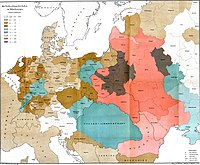
Photo from wikipedia
On the Threshold of the Holocaust: Anti-Jewish Riots and Pogroms in Occupied Europe. Warsaw–Paris–The Hague–Amsterdam–Antwerp–Kaunas (new edn.), Tomasz Szarota (Frankfurt am Main: Peter Lang, 2015), 217 pp., hardcover $60.95, electronic… Click to show full abstract
On the Threshold of the Holocaust: Anti-Jewish Riots and Pogroms in Occupied Europe. Warsaw–Paris–The Hague–Amsterdam–Antwerp–Kaunas (new edn.), Tomasz Szarota (Frankfurt am Main: Peter Lang, 2015), 217 pp., hardcover $60.95, electronic version available. Tomasz Szarota is a member of the Institute of History of the Polish Academy of Sciences, with several books and scholarly articles on Holocaust-related subjects to his credit. This study, his first to be translated into English, is a meticulously researched and thought-provoking contribution to the field. He justifies his project at the outset by observing that the anti-Jewish riots occurring shortly before the outbreak of World War II and in its early stages have been neglected by authors of general histories of the war and the Holocaust. The rest of his book makes the case that remedying this situation has much to offer students of that era. Studying the anti-Jewish riots and pogroms in Warsaw, Paris, the Hague, Amsterdam, Antwerp, and Kaunas is an unusually difficult research task. Large gaps in the documentary record, the reticence—at the time and afterward—of the major perpetrators, the nature of the contacts between the German authorities and native “patriots,” the great disparities in levels of destruction and numbers of deaths, the receptiveness in the general population to anti-Jewish violence—all these critical elements elude a high degree of precision. Szarota frankly concedes that at times we must rely on conjecture and circumstantial evidence “if we want to look into this phenomenon at all” (pp. 12–13). He is not giving himself an alibi to proceed with impunity; he lets the reader know when he is speculating, pointing to alternate interpretations that are supportable on the sketchy evidence, and noting the differing interpretations that exist in the literature. He is, in fact, both cautious about his conclusions and determined to get at the best possible version of the truth. Szarota takes a comparative approach to the case studies, limiting his investigations to countries occupied by the Germans. The similarities are revealing. Germans as a rule did not participate in the street violence. In Paris and Warsaw, they transported pogromists to the sites of violence, in some cases providing them meals. The most important contribution the Germans had it in their power to make was the offer of impunity for the perpetrators of violent actions—up to and including murder. Szarota does his best to document instances of direct German encouragement of “self-cleansing actions.” He succeeds convincingly in establishing a direct German link to the destruction of several synagogues in Paris (October 2–3, 1941) and the mass murder of Jews in Kaunas (June 25–29, 1941). In Kaunas, the leader of
Journal Title: Holocaust and Genocide Studies
Year Published: 2017
Link to full text (if available)
Share on Social Media: Sign Up to like & get
recommendations!